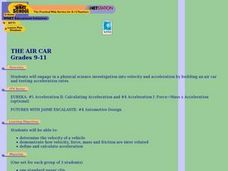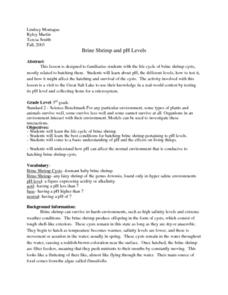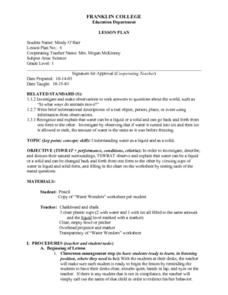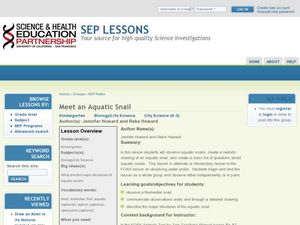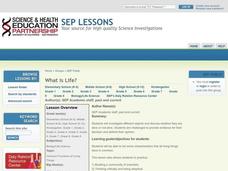Curated OER
The Air Car
Young scholars, in groups, design and construct an air car capable of acceleration. They view a video on acceleration, test their cars and make adjustments as desired.
Curated OER
Introduction to Toxicology
Students explore the science of toxicology and the relationship between a toxic reaction (response) and amount of substance (dose). They observe two demonstrations illustrating the concept of dose-response.
Curated OER
Brine Shrimp And Ph Levels
Third graders investigate the different ph levels found in water that is tested using simple measurements. The water samples are taken from a local body of water. The ph levels are used to help indicate areas where shrimp can thrive in...
Curated OER
Soil Samples
Students complete experiments in which they test the amount of humus in soil samples. They record their data and discuss the results. They write a story about soils to end the lesson.
Curated OER
Photosynthesis: Intake of Carbon Dioxide - Production of Oxygen
High schoolers, after a long-term observation of photosynthesis with aquatic plants, assess the benefits of photosynthesis towards all living organisms. They explain in their own words the two cycles within photosynthesis. Guided...
Curated OER
Let's Light Up a Light Bulb!
Third graders investigate the concept of how electricity works in the lighting of a light bulb. They construct a circuit in order to follow the path of electricity and test how it can travel in a wire system. Then the light bulb is lit...
Curated OER
What is a Living Thing, and How Does a Living Thing Respond to Its Environment?
Young scholars investigate how living things interact with their environment. In this living things lesson plan, students complete lessons for science investigations on what living things have in common. Young scholars study cells,...
Curated OER
The Role of Density in Sinking or Floating: Relational Causality
Students consider density and how it affects sinking and floating. Students make predictions, test liquids, and observe why some liquids sink and others float. They perform experiments to determine relational causality and how liquids...
Curated OER
Helicopter Design Company
Students test different designs of helicopters to determine what of the four designs will fall the slowest. In this helicopter lesson students complete an activity and fill out their worksheet.
Curated OER
String Telephone
Learners construct a string telephone. For this communications lesson, students use a cup, lead pencil, and a piece of string to construct a string telephone. The learners test their telephone with a classmate.
Curated OER
An Adaptation of Microbe Hunters
Students dramatize a two act play in which scene one depicts the story of Lazzaro Spallanzani and the second act deal with Louis Pasteur and his refutation of spontaneous generation.
Curated OER
Cool Suits
Students examine the materials that are used to make space suits. They complete an experiment in which they test different materials in different colors to determine the best one for keeping astronauts comfortable. They analyze the data.
Curated OER
Water - Solid and Liquid
First graders conduct a science inquiry by comparing water in its liquid and solid form. The students describe the different stages of water and complete a worksheet answering questions about each form of the water. Teacher assessment...
Curated OER
Meet an Aquatic Snail
Students explore aquatic snails. In this life science lesson, students create a class list of questions about aquatic snails and begin to observe aquatic snails in the classroom. Students record observations.
Curated OER
What Does Life Look Like Under a Microscope?
Students discover cells make up all living things. In this life science lesson, students investigate living organisms and the cells that create them. Finally the students create a testable question, conduct an investigation, and draw...
Curated OER
Eek, It leaks!
Students construct model landfill liners out of two-inch strips of garbage bags within resource constraints. The challenge is to construct a bag that will hold one cup of water without leaking. This represents similar challenges that...
Curated OER
Introduction to the Scientific Method
Students discover the scientific method. In this science lesson plan, students explore the steps of the scientific method as they participate in a classroom activity.
Curated OER
How Does Flowing Water Shape a Planet's Surface?
Students investigate how flowing water influence landforms. In this earth science lesson, students observe water behavior as it flows from the stream table at various inclinations. They discuss whether water shaped Mars landforms or not.
Curated OER
What is Life?
Students investigate the characteristics of living things. In this life science lesson, students examine several living and non-living specimens. Students determine which things are living and non-living.
Curated OER
Limiting Reagent
Students work in small groups with a small set of 8 nuts and 5 bolts to assemble into combinations of 1 nut: 1 bolt, and 2 nuts: 1 bolt. They explore the outcome and discuss. Then a student mixes two clear, colorless solutions together...
Curated OER
Water Quality Survey: Monitoring the Sustainability of Pigeon Creek
Students research the History of Pigeon Creek (or any watershed in your area). For this environmental science lesson, students conduct field tests such as pH and nitrates. They collect data and compare what they collected with other groups.
Curated OER
Reaction Time 2: Zap!
Students show how skills can improve through practice and awareness, using a reaction-time activity that focuses on both visual and auditory responsiveness.
Curated OER
Alcoholic Fermentation in Yeast
Biology classes will bubble with excitement as they complete this assignment. Beginning with an informative overview of cellular respiration and fermentation processes, the highlight comes as an experiment in determining the rate of...
Towson University
Mystery of the Crooked Cell
Can your class solve the Mystery of the Crooked Cell? Junior geneticists collaborate to learn about sickle cell anemia in a fascinating lesson plan. The included materials help them to examine the genetic factors behind the disease...


